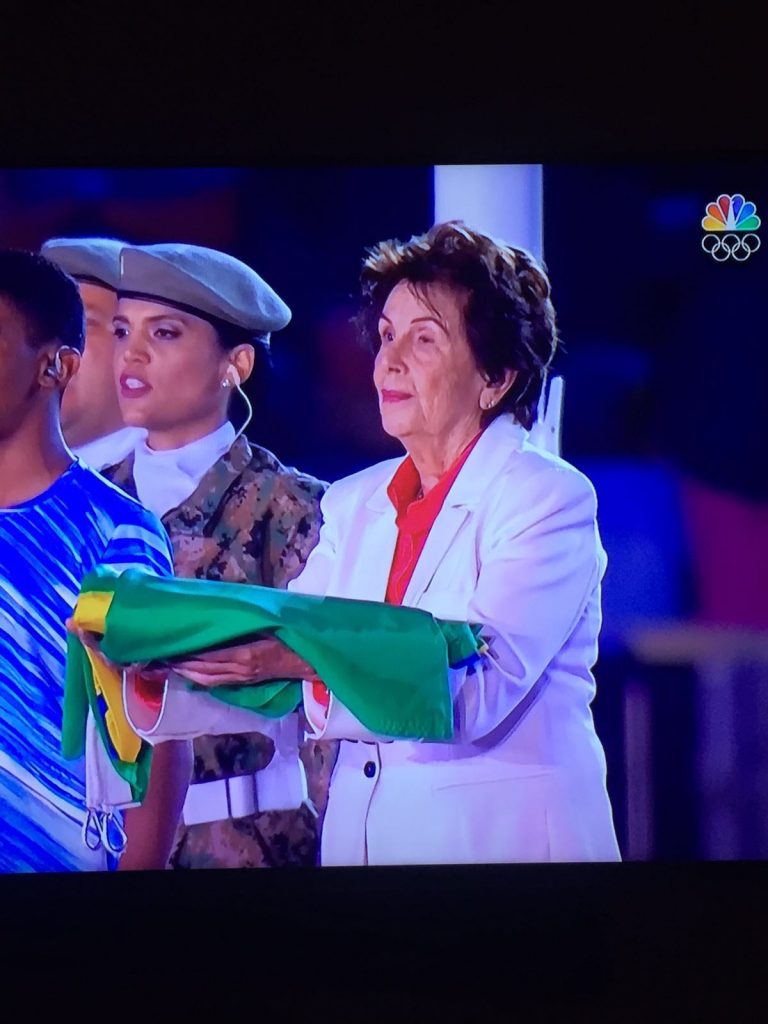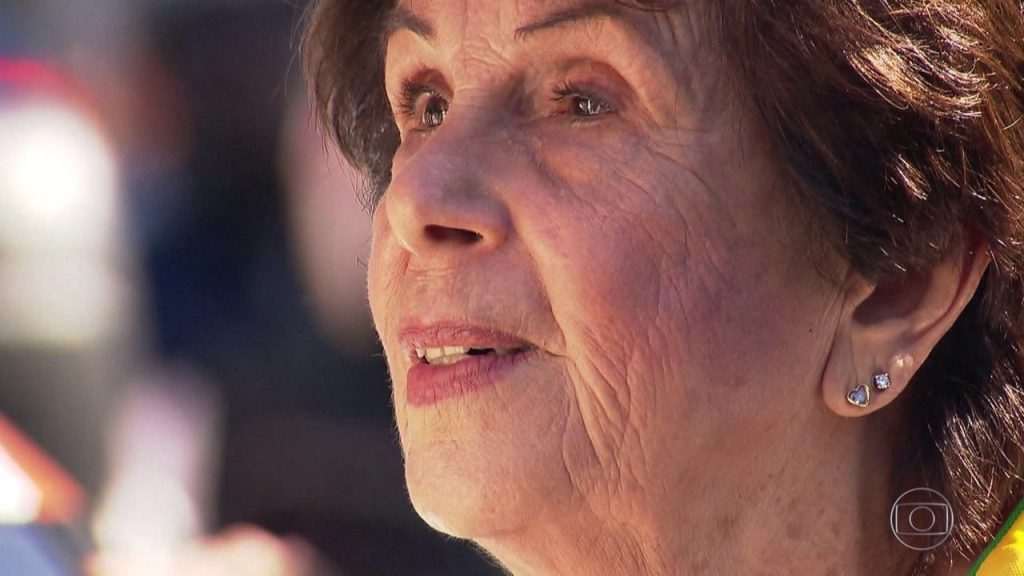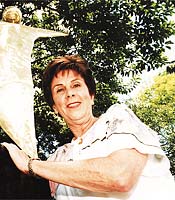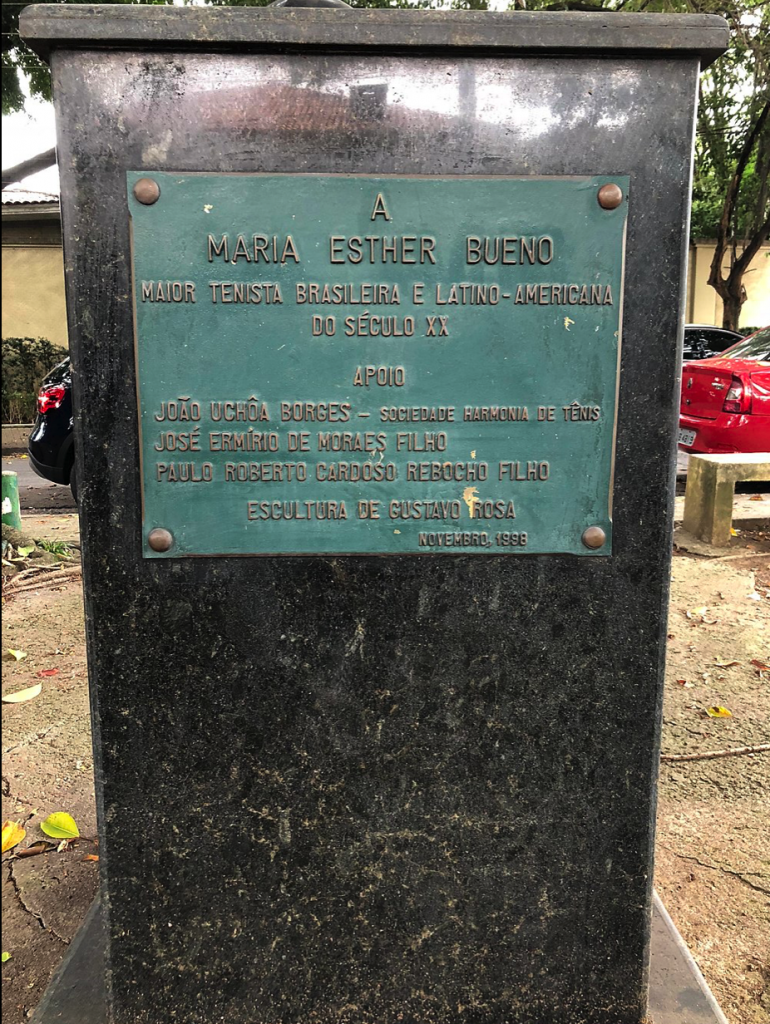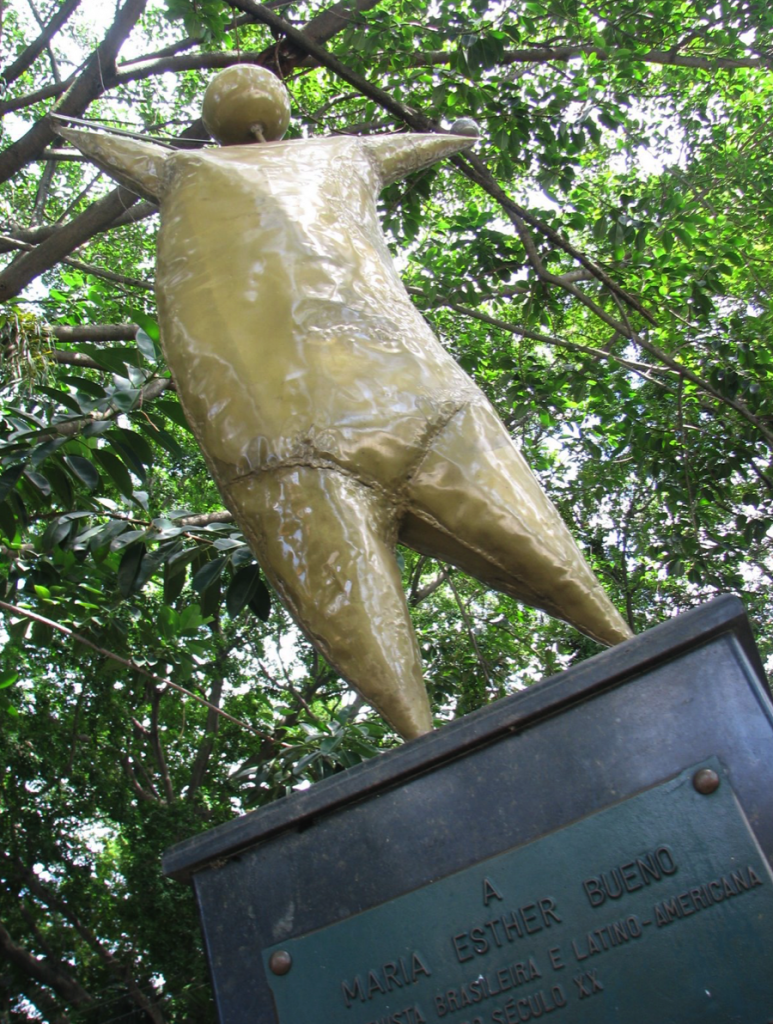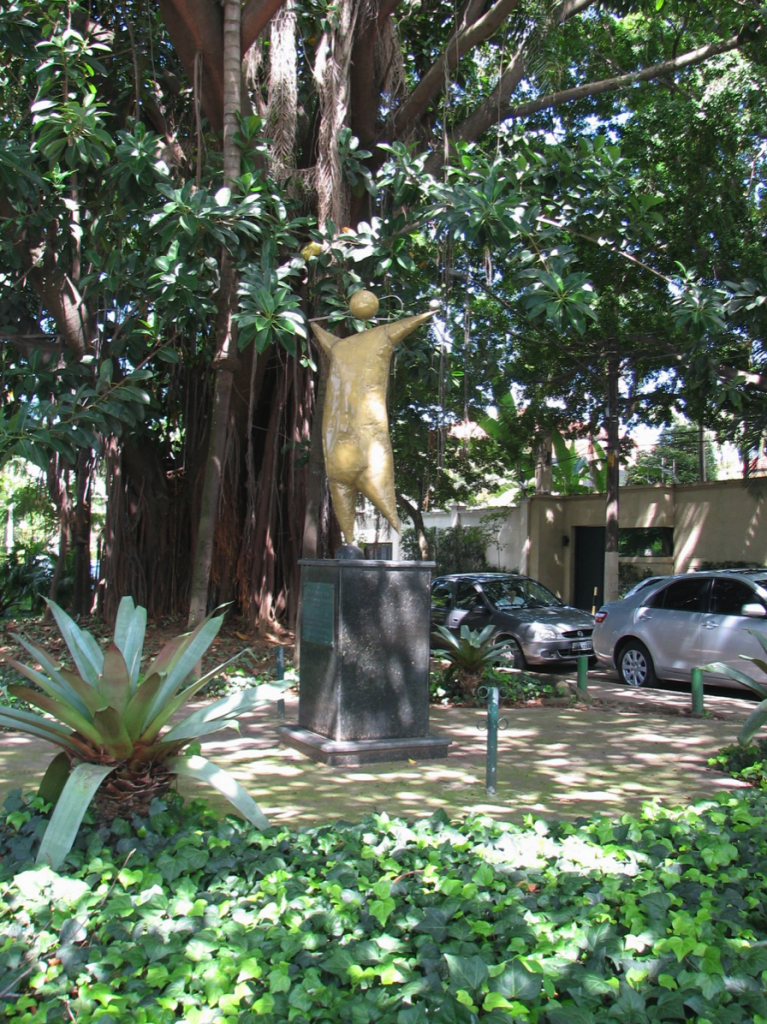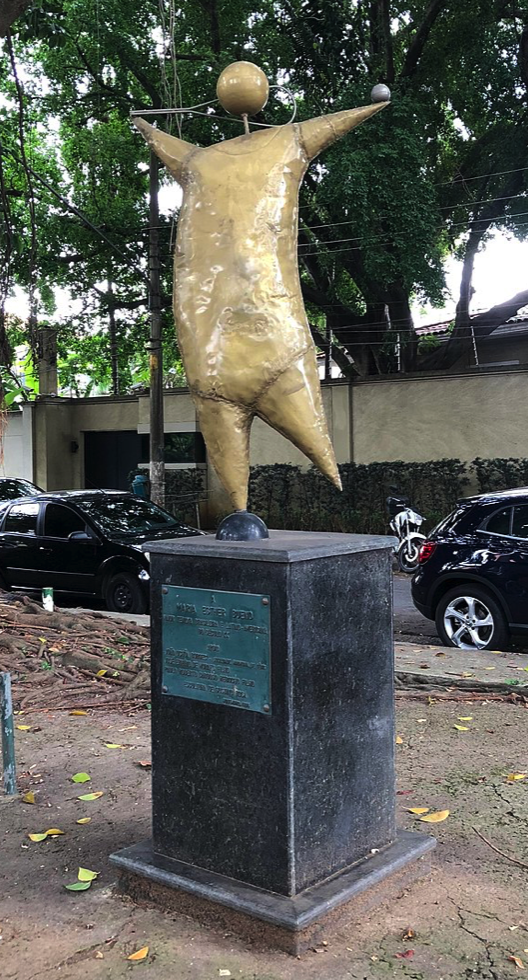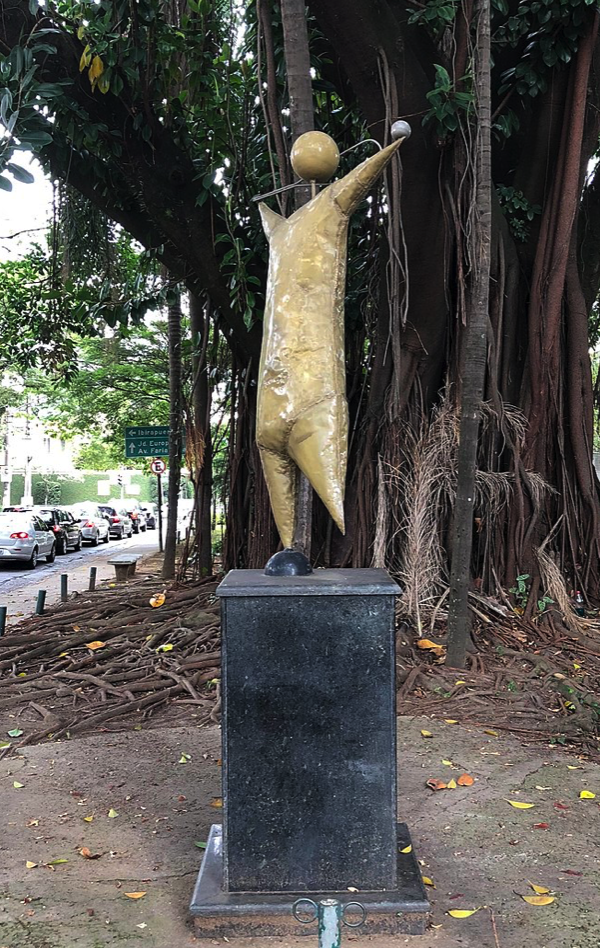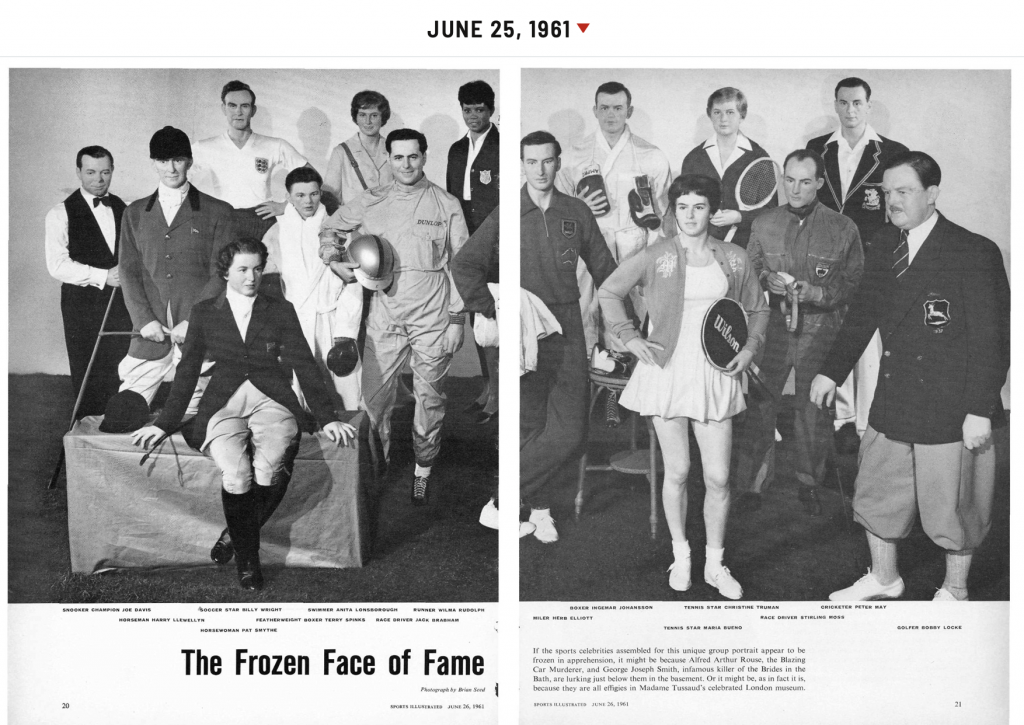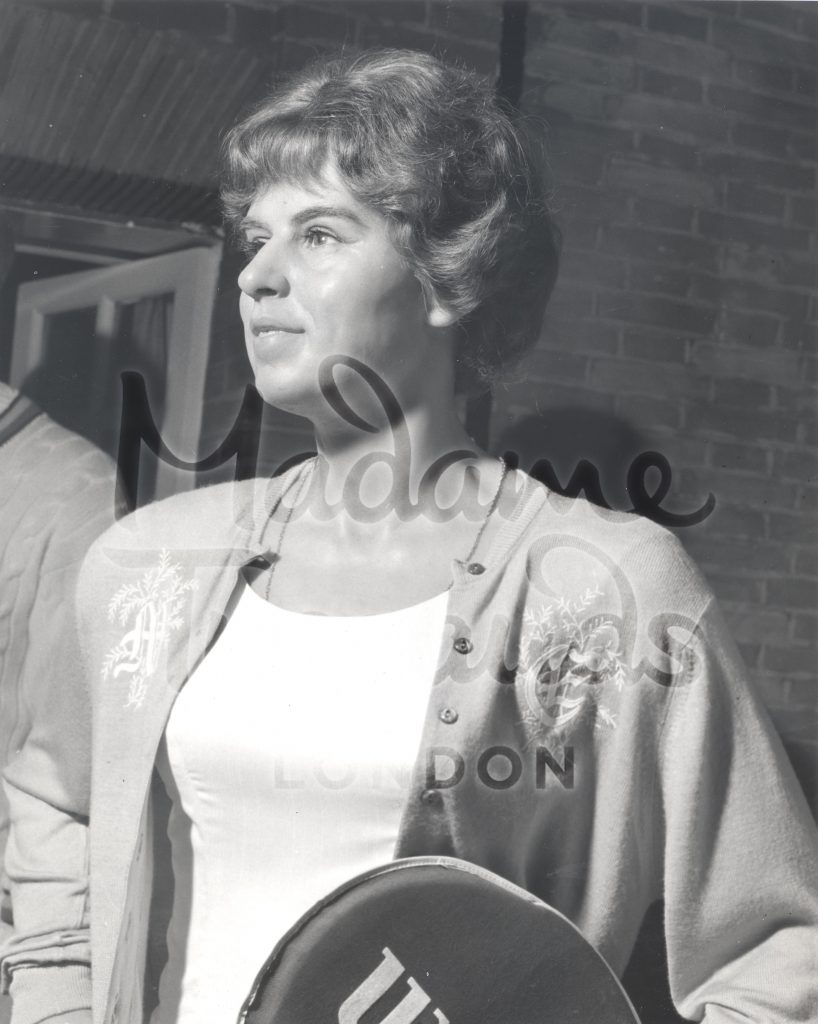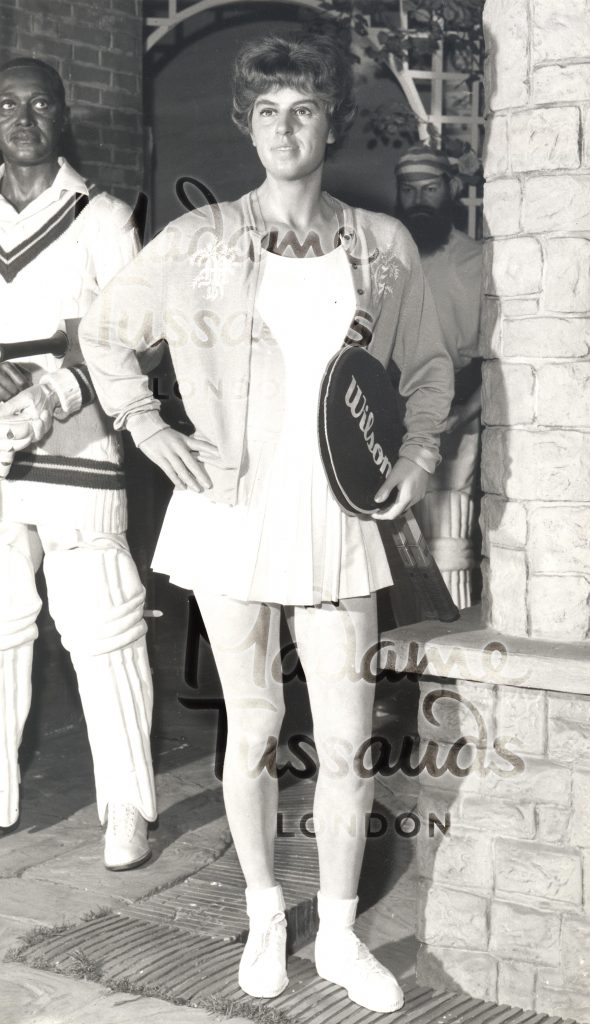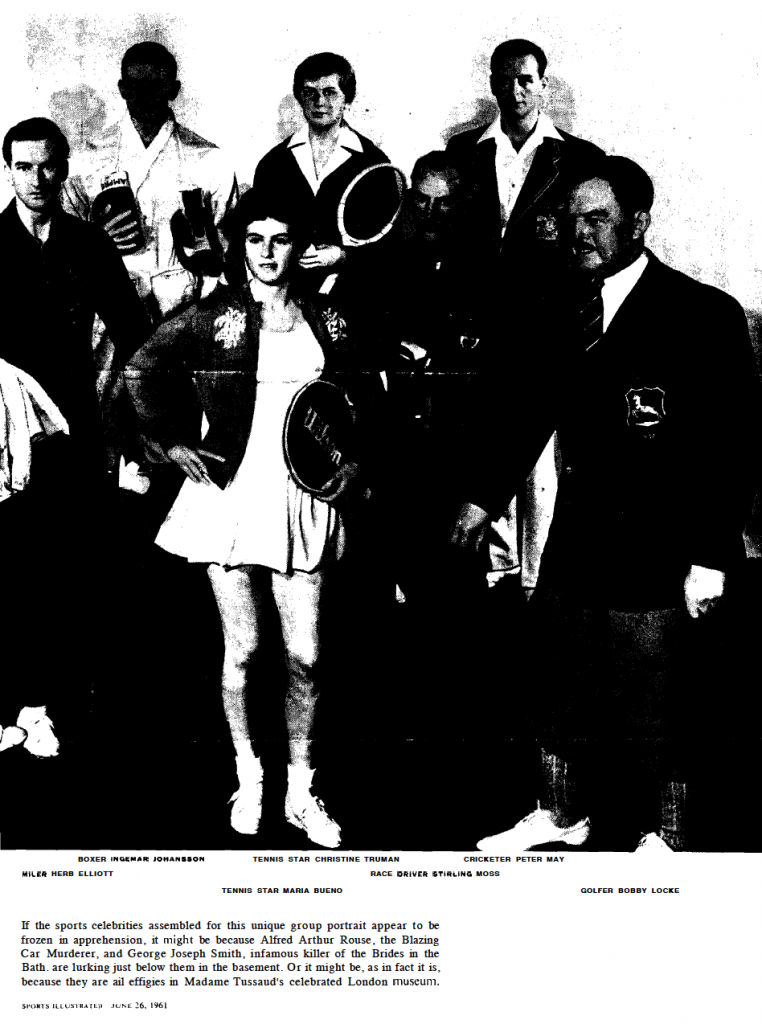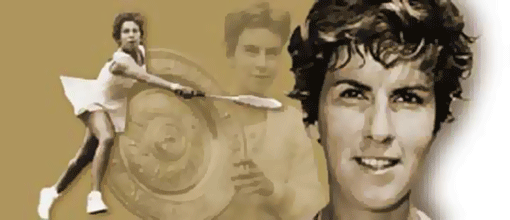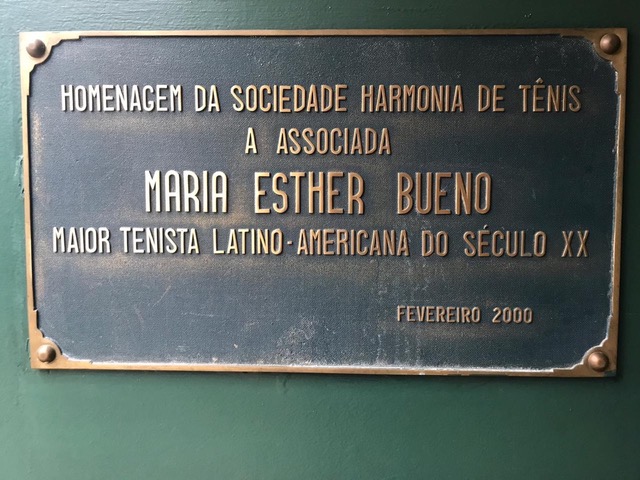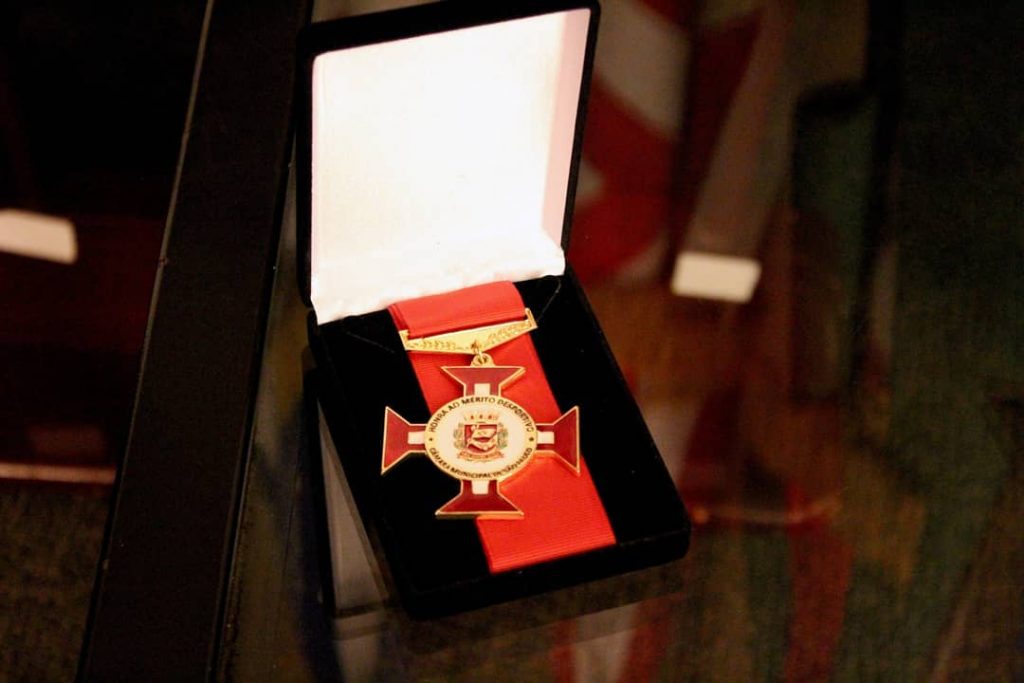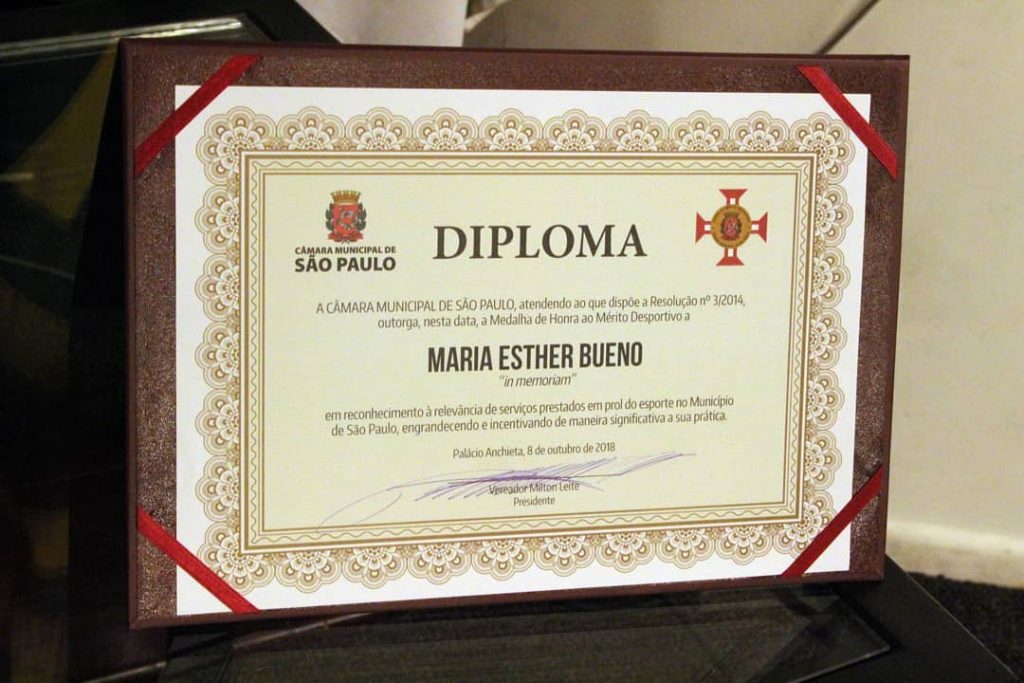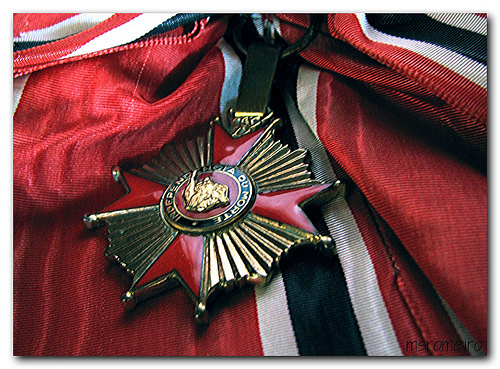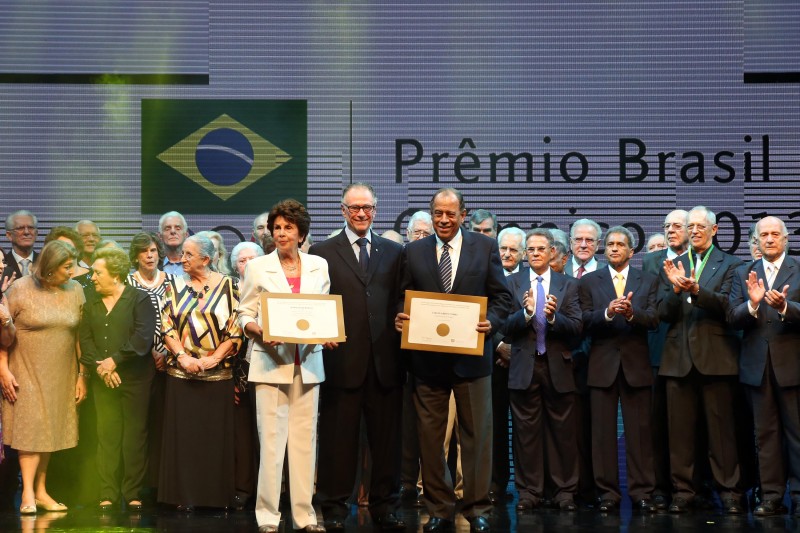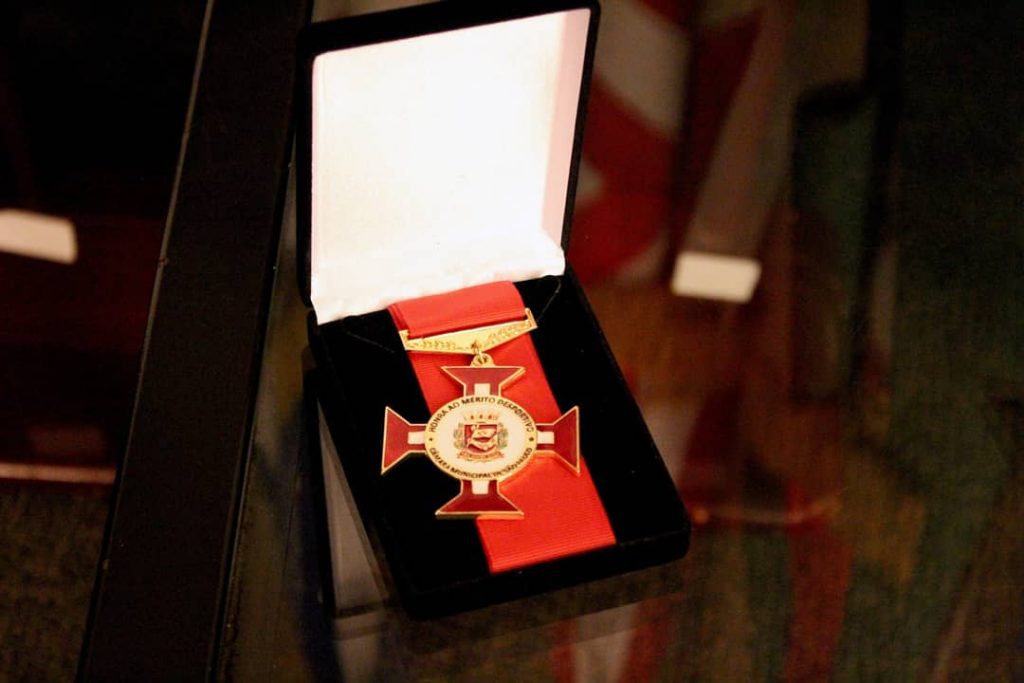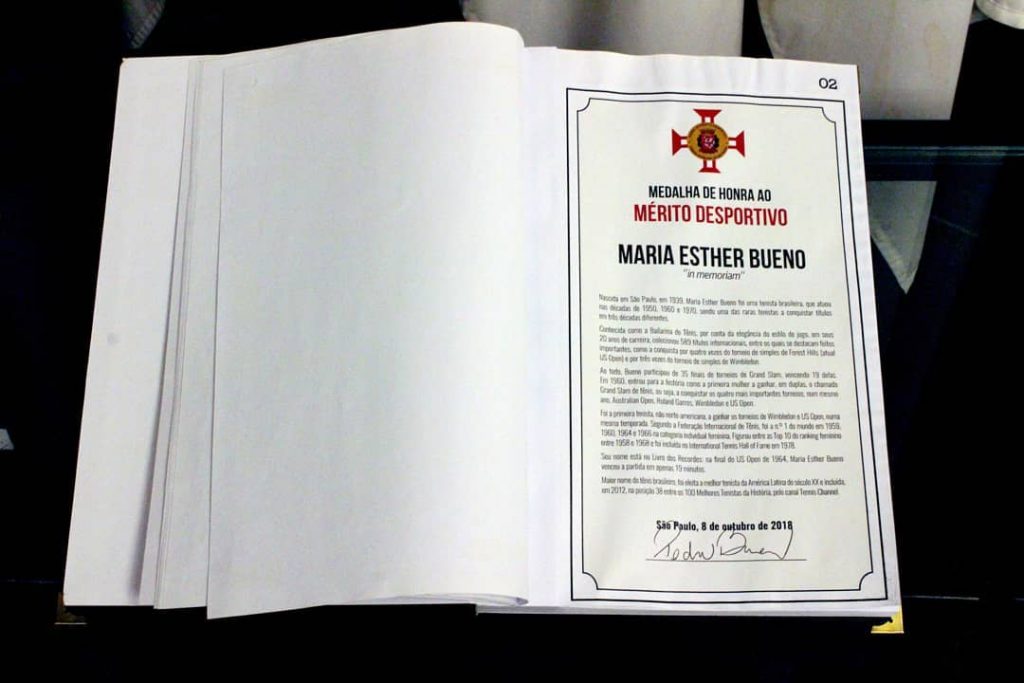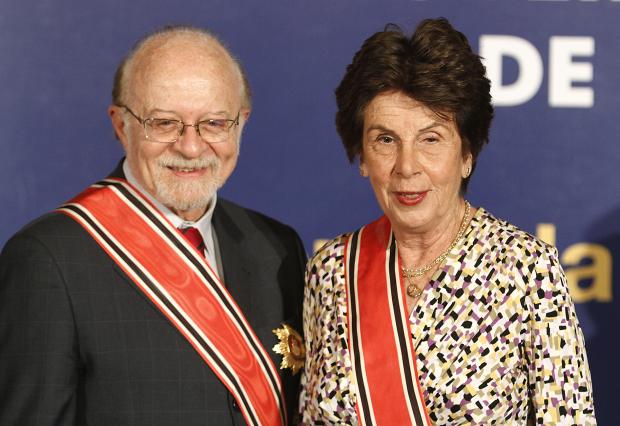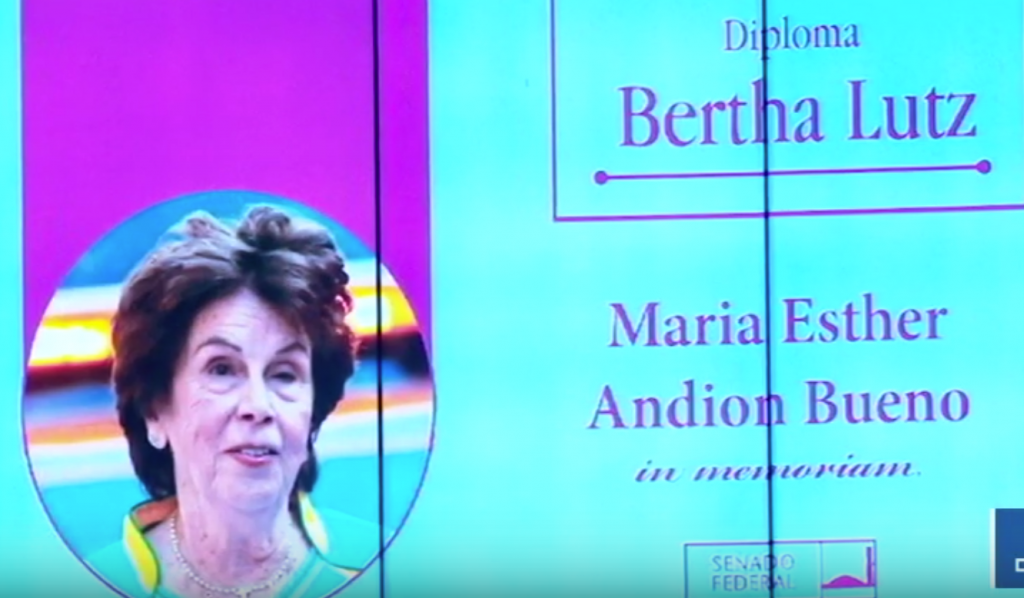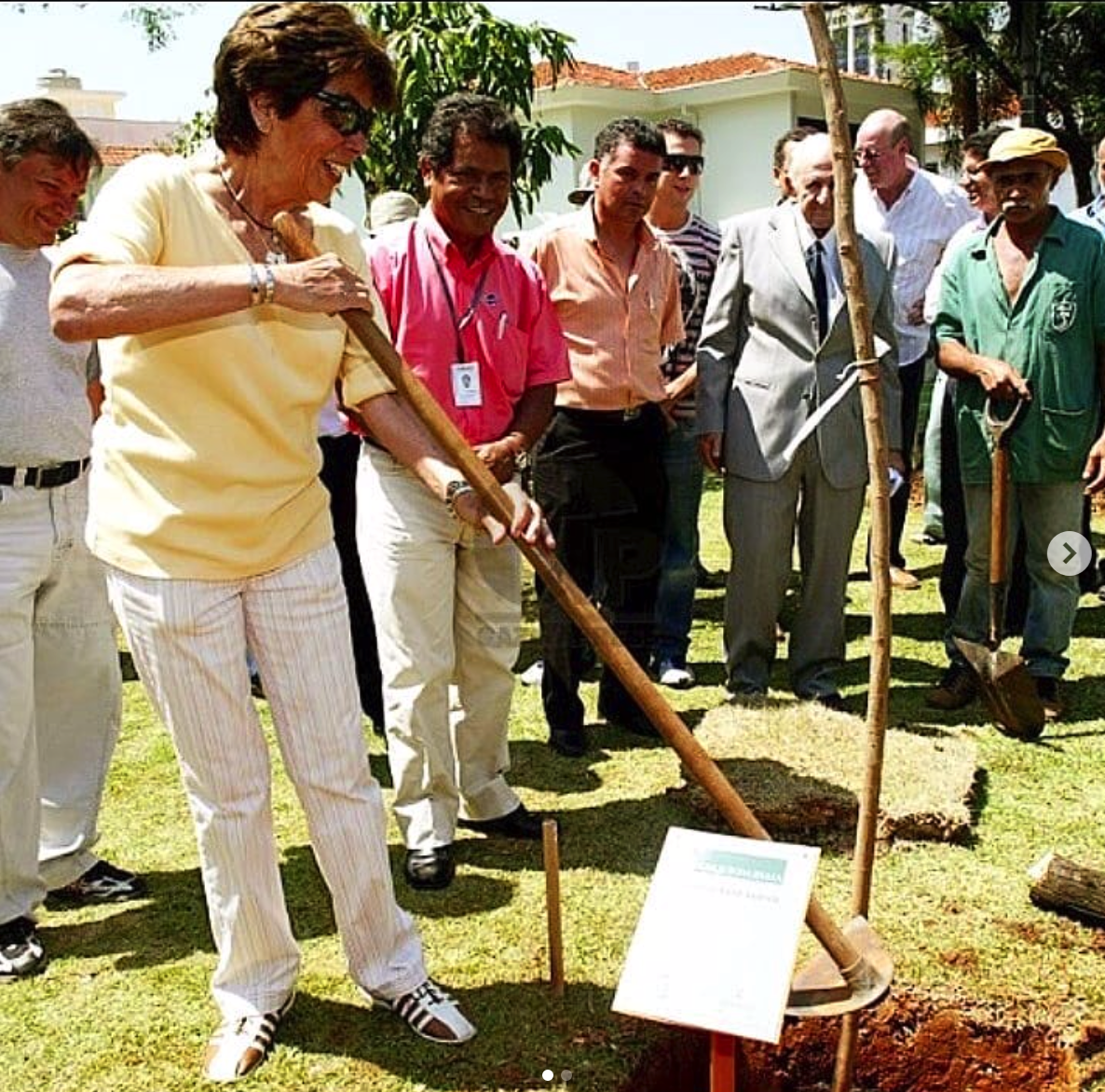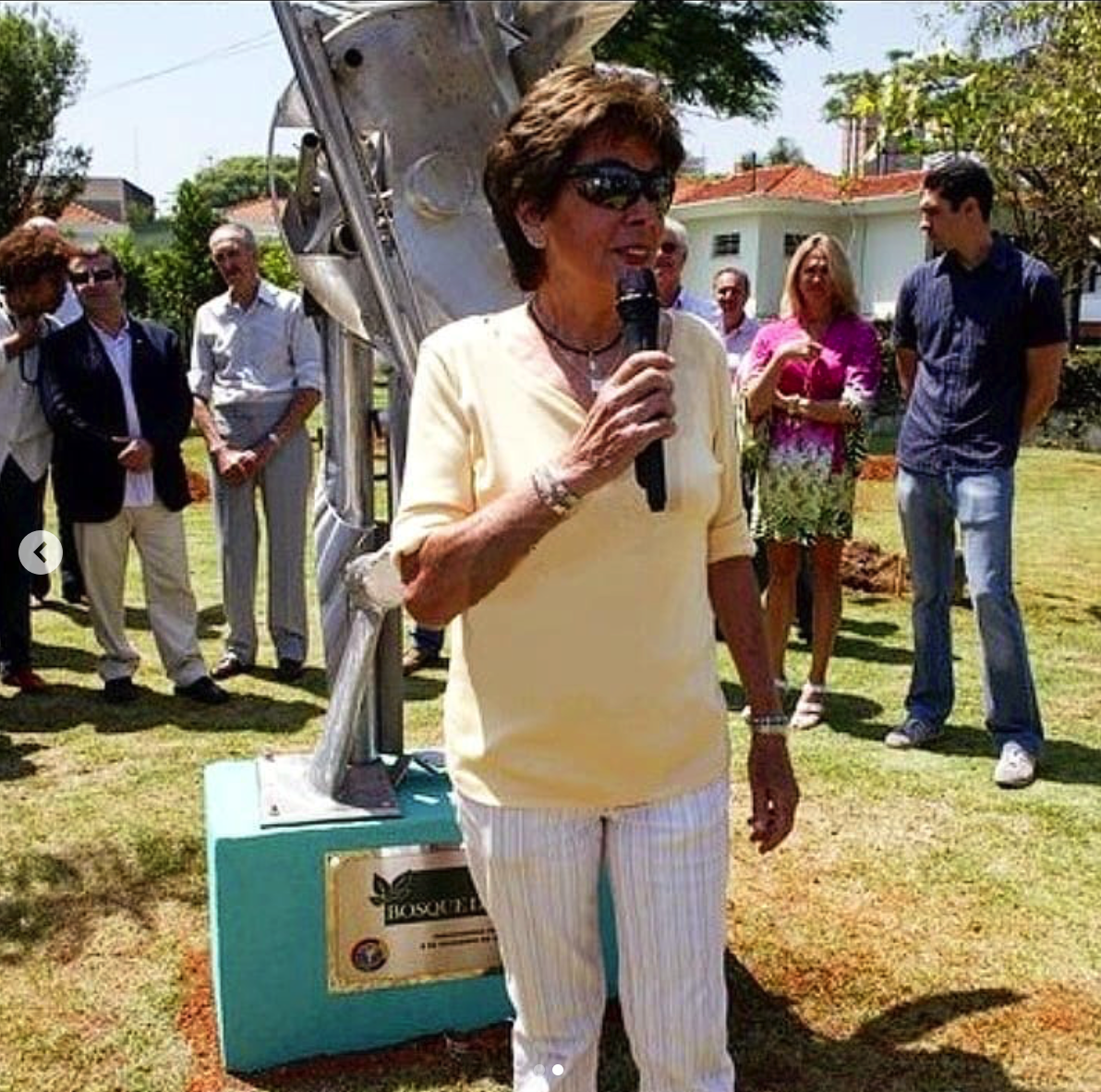In Memorium
 Maria Esther Bueno’s memory is being kept alive, particularly in Brazil and is immortalised there and around the world.
Maria Esther Bueno’s memory is being kept alive, particularly in Brazil and is immortalised there and around the world.
The Maria Esther Bueno Cup held in November 2018 at the Sociedade Harmonia de Tênis, her home club in São Paulo, is testimony to the will of her fans to pay tribute to this great champion.
Alongside the tournament for the best Under 23-year olds in Brazil, the club found a permanent home for a bronze that Maria Esther held very dear to her heart.
This was one of four identical statues by Brazilian artist Arlindo Castellane de Carli (1910-1985), named The Ballerina, the two largest of which are located at Tietê and Pacaembu.
Seventy centimetres tall, this smaller statue depicting Maria’s unique elegance and style held pride of place in Maria Esther’s apartment and was bequeathed by her family to Harmonia, where it now stands on the lawn close to her favourite court.
She would have appreciated this posthumous tribute, and the inauguration which was attended by her nephews during the Maria Esther Bueno Cup..
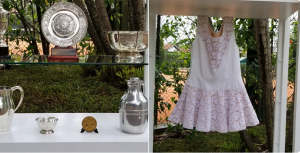 Passion, perseverance and humility were the hallmarks of her amazing career in which she won 19 Grand Slams and 584 titles to become the greatest Latin American tennis player of all time.
Passion, perseverance and humility were the hallmarks of her amazing career in which she won 19 Grand Slams and 584 titles to become the greatest Latin American tennis player of all time.
There was also an exhibit of Maria Esther’s trophies and dresses.
The fourth, a 20cm high miniature statue by Castellane, has been kept by her family.
Clube de Regatas Tietê
Maria Esther Bueno died on 8 June, 2018, at the age of 78, leaving a lasting legacy, and there are now, in fact, five statues in existence as well as a sculpture of her in São Paulo.
The two large statues have adorned the city of her birth for many years, the first being unveiled in 1959 at the Clube de Regatas Tietê in the north of São Paulo where she and her family played as she grew up in the house where she was born across the road on Guaporé Street.
Tietê was founded in 1907 and had around 30,000 members, but it was forced to close in November 2012 after being unable to pay off debts of nearly R$ 25 million.
The land it had occupied for 105 years was leased by the City Hall, which terminated the agreement in 2009.
When the club did not return the land, a lawsuit was instigated by the municipal administration to recover it, placing the club in jeopardy.
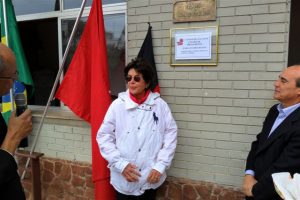 After a three-year legal dispute, Tietê was eventually forced to close its gates, asking Maria Esther to unveil a plaque in the grounds.
After a three-year legal dispute, Tietê was eventually forced to close its gates, asking Maria Esther to unveil a plaque in the grounds.
Two years later, the City had renovated the facilities and, in February 2014, the Tietê Club re-opened, this time as a public space with free access to the multipurpose leisure and sports centre and its four tennis courts, five gyms, four multi-sport courts and basketball courts, a fitness room and a 20,000-square-foot free-running arena making up the new amenities.
Maria Esther is immortalised in this statue, which depicts her in a classic pose, playing a backhand half-volley, now fully restored having endured through all the turmoil and standing at the entrance of the Tietê Leisure Sports Center.
- Maria Bueno photographed with her statue at the Tiete Club in Sao Paulo in July 1986
- Estátua da tenista Maria Esther Bueno, três vezes vencedora em Wimbledon
Maria’s tennis story began early, when she was just three years old, playing with her parents and her brother at the Tietê Club, which was just across the street from the family home.
“My parents practiced at the club and I and my brother Pedro grew up playing tennis together. There is no reason, it just happened, it was a natural thing for me to play tennis,” she said many times.
She was a state champion twice in swimming, another very traditional sport at Tietê.
It was a haven for the two children, who enjoyed the wide range of facilities the club had to offer, including the two swimming pools, the five outdoor tennis courts (and one indoors), gymnasium, and running track.
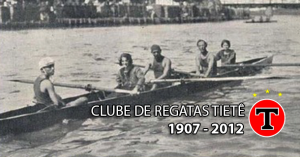 Their father became the number one member at the club and not only played tennis there but also pursued rowing in the nearby River Tietè.
Their father became the number one member at the club and not only played tennis there but also pursued rowing in the nearby River Tietè.
The club offered 21 different sports to thousands of members and their families but in recent years it had fallen into decline.
Maria Esther’s competitive career began in 1950 when she was 11 years old and, by the age of 14, she became both the Brazilian youth and adult champion, after which she began to gain prominence.
At the age of 18, she won her first world title at the Orange Bowl in the United States.
When Maria won her first Wimbledon singles title in 1959 Tietè commissioned the statue of her and after she took her third Wimbledon crown, they included three stars on the club flag and uniforms to commemorate the remarkable achievement.
The club’s trophy room was full of memorabilia relating to Maria’s exploits alongside the many successes of the teams and athletes from a variety of sports.
“I am very sad to see Tietè close,” Maria told the many reporters present in 2012.
“When everyone is trying to talk about giving incentives to encourage people to play sport, the club is forced to close because they owe a lot of tax, which they cannot pay.
“In the end, it is the members and their families that lose out, which is a great pity.
“I am very pleased that Harmonia is trying to save my statue and have offered to move it to a square behind the club and to look after it. It would be such a shame if that, too, disappeared.”
In the end, the statue remained where it was and continues to stand there to this day.
The Bueno family moved from Tietè to the Club Sociadade Harmonia de Tenis in 1967 but always remained in contact with the old club where Maria was a much-valued honorary member.
Only recently Tietè renewed the plaques that many years ago dedicated court 1 to Maria and Court 2 to her brother Pedro in recognition of their tennis achievements.
Pacaembu
- Maria Esther Bueno/ 31 October 1989
- Maria Esther Bueno and guests, during the ceremony in Charles Miller Square (Pacaembu), for the reopening of her statue (which was restored in the broken racket) with the sponsorship of the São Paulo Municipal and State Secretaries of Sport and Tourism – Charles Miller Square – Paulo Machado de Carvalho Stadium (Pacaembu) – Sao Paulo – SP – Brazil – 10/30/1989 – Photo: Collection / Gazeta Press
The second large statue stood for many years in front of the vast Pacaembu football stadium until the construction of the swimming pool in 1995.
In 1960, the bronze statue was installed on Charles Miller Square in front of the stadium but was later moved to a location near the tennis courts in the 1990s.
By then vandals had broken the racket she held but the statue was restored by its creator, Arlindo Castellane de Carli, in bronze and concrete, and moved to a safer location within the grounds where it continues to stand today.
It was also in the 90’s that the Pacaembu Complex, including Charles Miller Square, was listed as a Historical Heritage of the City of São Paulo, proving the significant value it has with the society of São Paulo and protecting it for the future.
The Dr. Paulo Machado de Carvalho stadium, the full name of Pacaembu, covers 75,598 square meters and has a current capacity of 37,952 people, seated.
Pacaembu is not just about soccer and the stadium also features an indoor multisport gym, a heated Olympic-sized pool, an outdoor futsal court and an 860m Cooper track.
It also has a tennis complex with a fast-paced court and a covered clay court, as well as housing the tennis pavilion, built with the help of Italian immigrants.
The Maria Esther Bueno statue now presides over the main court there.
Destined for Olympic Park
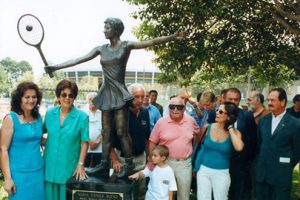 A fifth statue, striking a different pose, was originally located at the entrance of the headquarters of the Federação Paulista de Tenis on Uruana, in Vila Mariana, São Paulo, but was put into storage when the Federation moved its offices from Ibirapuera to the old downtown area few years ago.
A fifth statue, striking a different pose, was originally located at the entrance of the headquarters of the Federação Paulista de Tenis on Uruana, in Vila Mariana, São Paulo, but was put into storage when the Federation moved its offices from Ibirapuera to the old downtown area few years ago.
The Bueno family is approaching the FPT to have the statue placed at the Olympic Park in Rio de Janeiro where the Olympic Tennis Stadium is named after Maria Esther.
- Maria Esther Bueno with the plaque naming the Olympic tennis show court in Rio de Janeiro
- Aerial view of the Olympic Tennis Stadium with show Courts 1 and 2 beyond
- A group photocall
“I can’t tell you how thrilled and excited I am to be honoured with the naming of the Olympic Tennis Stadium in my name!” Maria Esther said when the Olympic Tennis Centre’s main show court was officially opened in her name.
“It makes me feel connected with the Olympics next year in a way I never imagined possible, as well as being a part of the legacy that this fantastic place will give to tennis in years to come.”
Involvement with the 2016 Rio Games was one of Maria Esther’s most proudest achievements, and carrying the torch down the main street in São Paulo her greatest thrill.
“Carrying the torch is an unbelievable honour, something I never imagined would happen to me. It is very exciting for me!,” she said at the time.
“I never had a chance to be really involved in the Olympics until now, although I covered it (for TV Globo) in London 2012 and Beijing from Rio.
“To have the Games here in Brazil, to be an ambassador to Bradesco and the Organising Committee and to be carrying the torch is a dream come true!”
- Maria Esther Bueno with the plaque naming the Olympic tennis show court in Rio de Janeiro
- On the court
- Maria Esther Bueno passes on the Olympic Flame
- Maria Esther with the torch and her escort
- The Brazilian flag is raised [AP Photo/Matt Dunham]
- The proudest of moments
Maria Esther had the honour of opening the Closing Ceremony of the 31st Olympic Games at Rio’s Maracanã Stadium, saying: “It was the proudest moment of my life.”
The segment opened the final proceedings with Maria Esther standing on the platform with the folded flag, which she presented to the audience and then handed to the Brazilian Army Major alongside to pass on to the Colour Guard, who hoisted it high on the flagpole alongside the Olympic flag as the Youth Choir sang the Brazilian National Anthem and a giant rendition of the flag appeared around them on the video floor of the stadium.
“We all faced the flag as it went up and it was an incredible occasion,” she added. “It was just fantastic!”
It is therefore more than appropriate that a statue should grace her stadium in Rio.
Other Memorials
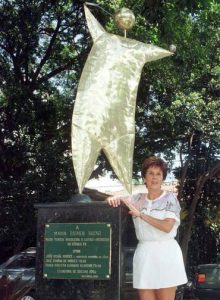 Outside the back entrance of Sociedade Harmonia de Tênis, in California Square, is a modernist sculpture representing Maria Esther Bueno.
Outside the back entrance of Sociedade Harmonia de Tênis, in California Square, is a modernist sculpture representing Maria Esther Bueno.
The creation of Gustavo Machado Rosa (1946-2013), the sculpture, which is made of marble and bronze and honours Brazil’s greatest champion, was unveiled in 1998 in Praça Califórnia.
It was commissioned by João Uchôa Borges (Sociedade Harmonia de Tênis), José Ermírio de Moraes Filo, and Paulo Roberto Cardoso Rebocho Filho.
She was not particularly enamoured with the piece but it is an important artistic monument visited by many tourists.
Madame Tussauds
Maria Esther was immortalised as a wax effigy at the world-famous Madame Tussauds [ https://www.madametussauds.com/london/en/] in London which, as a Brazilian, was a huge honour for her and she visited the exhibit at the time.
The figure went into the attraction in 1961 and was withdrawn in March 1964. She was reinstated that same July after regaining her Wimbledon title, but it has since been removed.
International Tennis Hall of Fame
In 1978 she was inducted into the International Tennis Hall of Fame in Newport [https://www.tennisfame.com/hall-of-famers/inductees/maria-bueno], Rhode Island, where a lasting tribute remains, while, in the year 2000, she was nominated the Best Latin American Tennis Player of the 20th Century in celebration of the Millennium.
A plaque commemorating this can be found at the entrance to the stadium court at Sociedade Harmonia de Tênis.
Mural and Awards
In the early 1980s the British artist Walter Kershaw was commissioned by the British Council to create a series of murals depicting Brazilian life and culture throughout the city of São Paulo, one of which including Maria Esther Bueno.
This has since disappeared but the main piece, Mural Brasil, has recently been restored and can be seen on a wall of the headquarters of FAAP, Armando Alvares Penteado Foundation (FAAP), one of the most prestigious and respected academic institutions in Brazil, on the corner of the streets Armando Alvares Penteado and Avaré.
Maria Esther received many important awards and medals throughout her lifetime, including the São Paulo medal and diploma, Medalha Anchieta e o Diploma de Gratidão de São Paulo, the highest accolade the state capital can bestow, in a ceremony held at the City Hall in October 2014.
The City Hall of São Paulo recently paid further tribute to Maria Esther in memoriam with the bestowing of the Medal of Honour to Sports Merit, an accolade awarded in recognition of services to sport in the Municipality of São Paulo.
The award was received by her eldest nephew, Pedro Bueno Jr and his daughter Nina, from Thomas Koch, friend of Maria Esther.
“It was a privilege for me to receive this honour, especially from the hand of Thomas, of whom I am a fan. I’m sure my aunt would be very happy, “said Pedro Bueno.
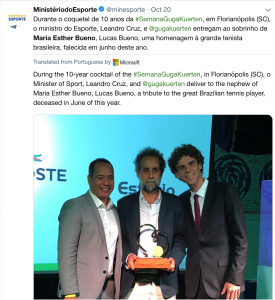 In Florianapolis, Maria Esther’s youngest nephew, Lucas, received a posthumous tribute from Gustavo Kuerten alongside Leandro Cruz, the Minister of Sport during the Brazilian’s tennis festival on 20 October 2018. This took the shape of a heart alluding to the shape that Guga drew in the French clay when he won the Roland Garros tournament in 2001.
In Florianapolis, Maria Esther’s youngest nephew, Lucas, received a posthumous tribute from Gustavo Kuerten alongside Leandro Cruz, the Minister of Sport during the Brazilian’s tennis festival on 20 October 2018. This took the shape of a heart alluding to the shape that Guga drew in the French clay when he won the Roland Garros tournament in 2001.
There are several trees planted in her name, including one to inaugurate the Forest of Fame in the Bicycle Park in in São Paulo alongside 27 sporting personalities in honour of the City’s World and Olympic Champions.
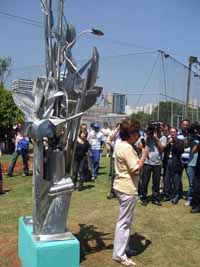 Before planting her tree next to Pelé’s in 2017, Maria said: “It’s great to be remembered, and it’s good to have that recognition.
Before planting her tree next to Pelé’s in 2017, Maria said: “It’s great to be remembered, and it’s good to have that recognition.
“It was a great honour and quite unexpected.
“I felt it was the best thing they could do to help keep the names of those who set the history of the various sports in the public’s eye. By preserving this memory in green, it is also a very modern and right thing to
do!”
She planted a Pau Cigarra, a species predominant in the Atlantic rainforest, and was told that it promised to grow very tall and would bloom with pretty blue flowers and a beautiful fragrance.
“In Brazilian tennis, no one came anywhere near me. After all, it’s 19 Grand Slams tournaments I’ve won and these achievements are forever. I put Brazil on the map when it comes to sports.
“This tribute is one more chance to worship the memory of all of us who have made a great deal of sacrifice in our careers,” she concluded.
Woodfield Grove Tennis Club
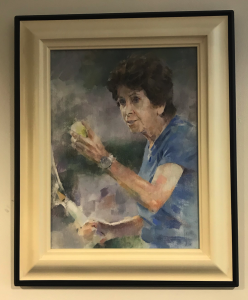 When Maria Esther died in São Paulo on Friday 8 June, 2018, members at Woodfield Grove Tennis Club in south London were shocked and saddened to lose one of their own.
When Maria Esther died in São Paulo on Friday 8 June, 2018, members at Woodfield Grove Tennis Club in south London were shocked and saddened to lose one of their own.
The committee decided to commission a portrait to grace the clubhouse in her memory, and to name the balcony that she opened in the autumn of 2013, the Bueno Balcony.
Luis Morris, an artist who specialised in the portrayal of tennis players and had gained commissions from the Lawn Tennis Association and the All England Club at Wimbledon, was asked to paint the oil portrait, which was completed on 5 December, 2018, and hung on the wall in time for the Christmas Party.
Morrris was born in 1963 in Wrexham, and studied at Nottingham University where he left his degree course in architecture in 1984 to to join De La Rue as an apprentice banknote designer.
In 1998 he left De La Rue to become a freelance artist/illustrator and, in 2002 obtained his diploma in Portraiture at Heatherleys School of Art.
A member of the Royal Institute of Oil Painters who has exhibited widely at galleries, fairs and institutions, Morris won the prestigious BP award at the National Portrait Gallery, London in 2007.
The portrait of Maria Bueno is one of his finest works and captures her character and humour perfectly.
On 9 May, 2019, a plaque was installed upstairs commemorating the Bueno Balcony for posterity.

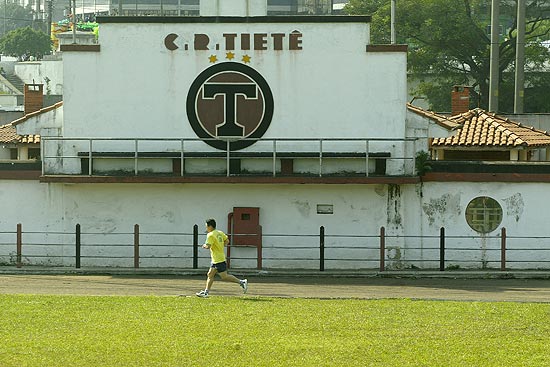
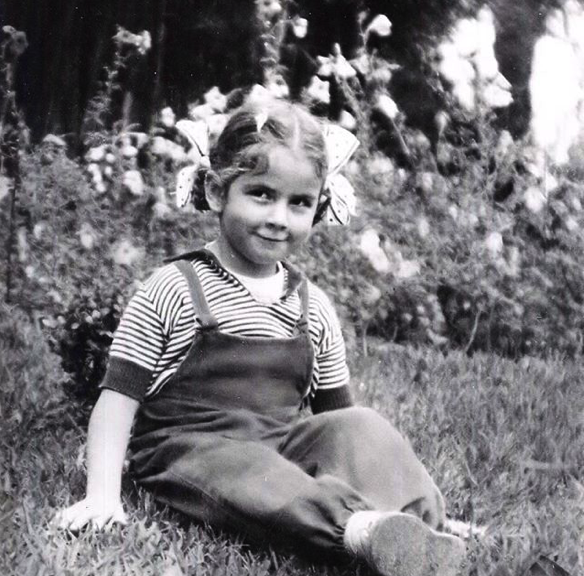
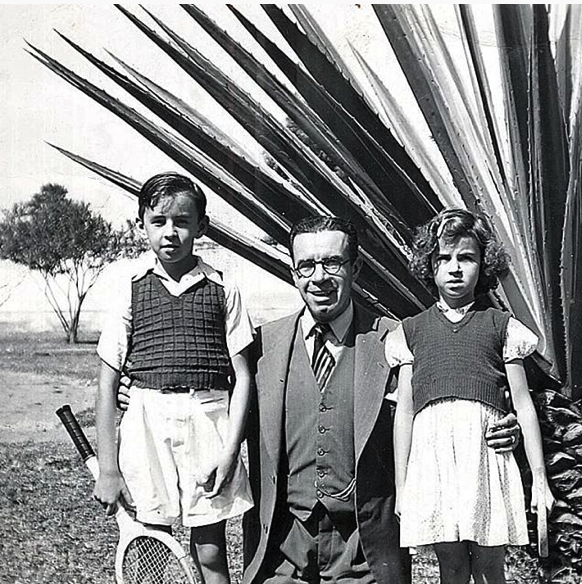
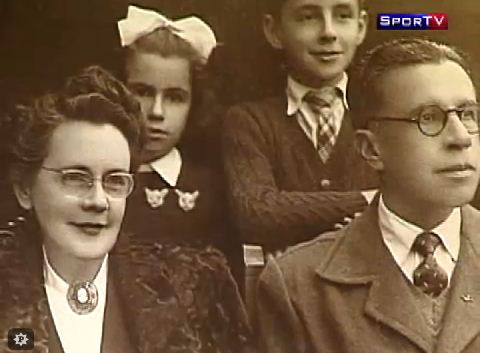
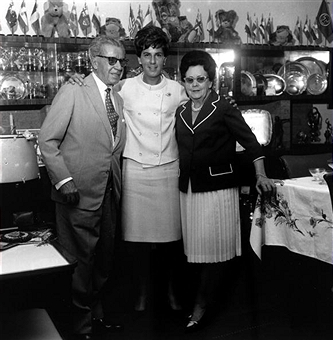
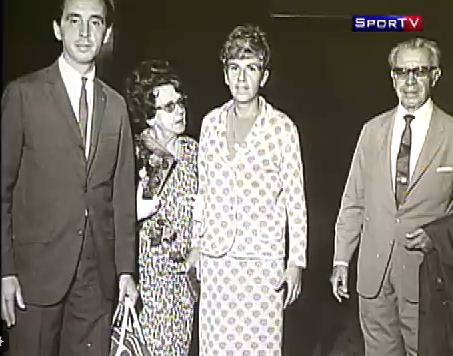
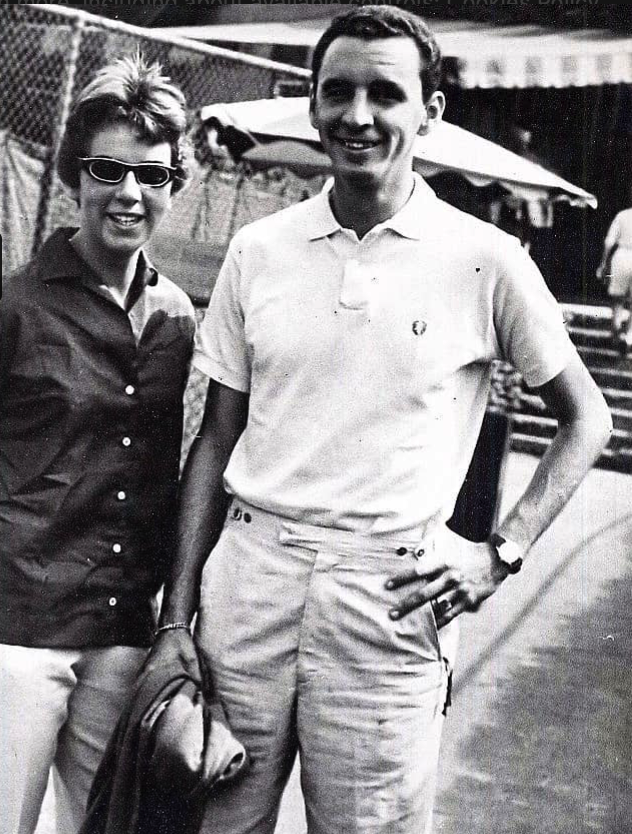
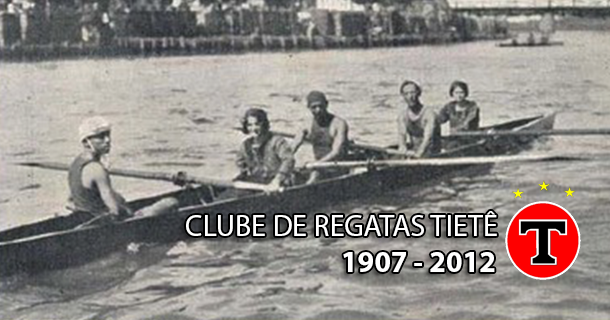
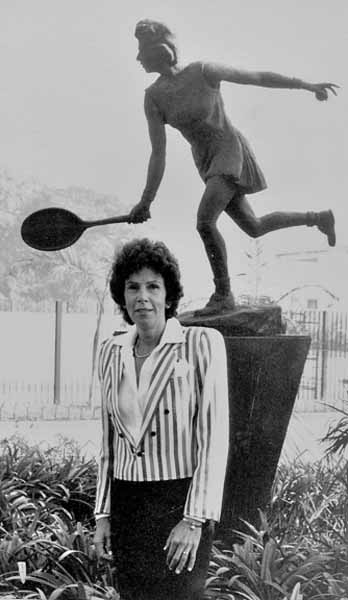
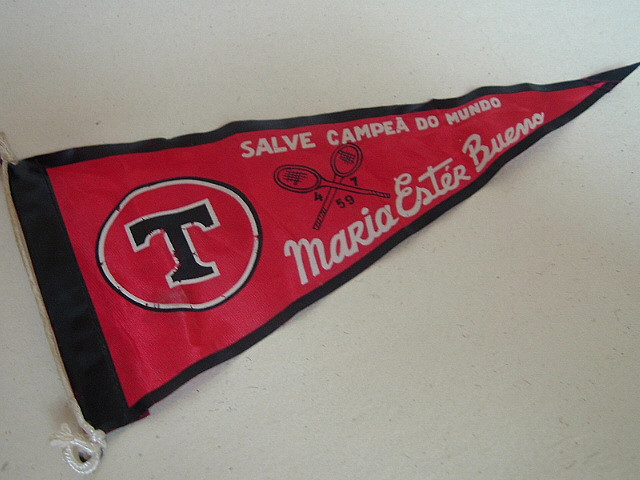
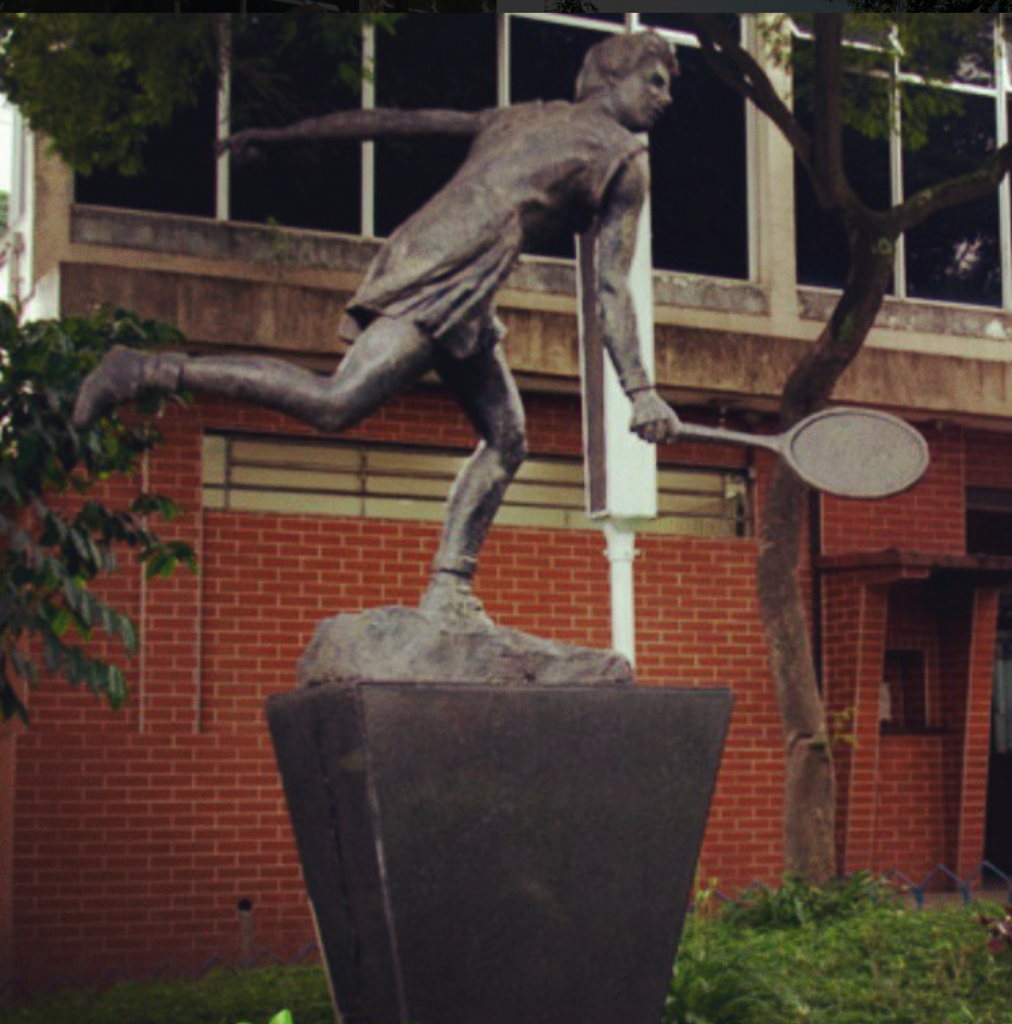
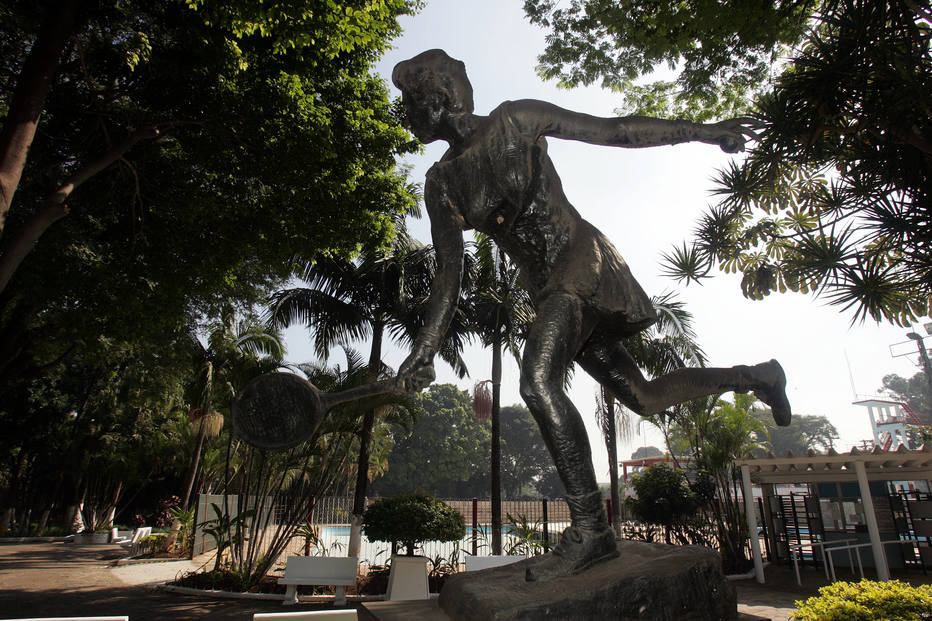
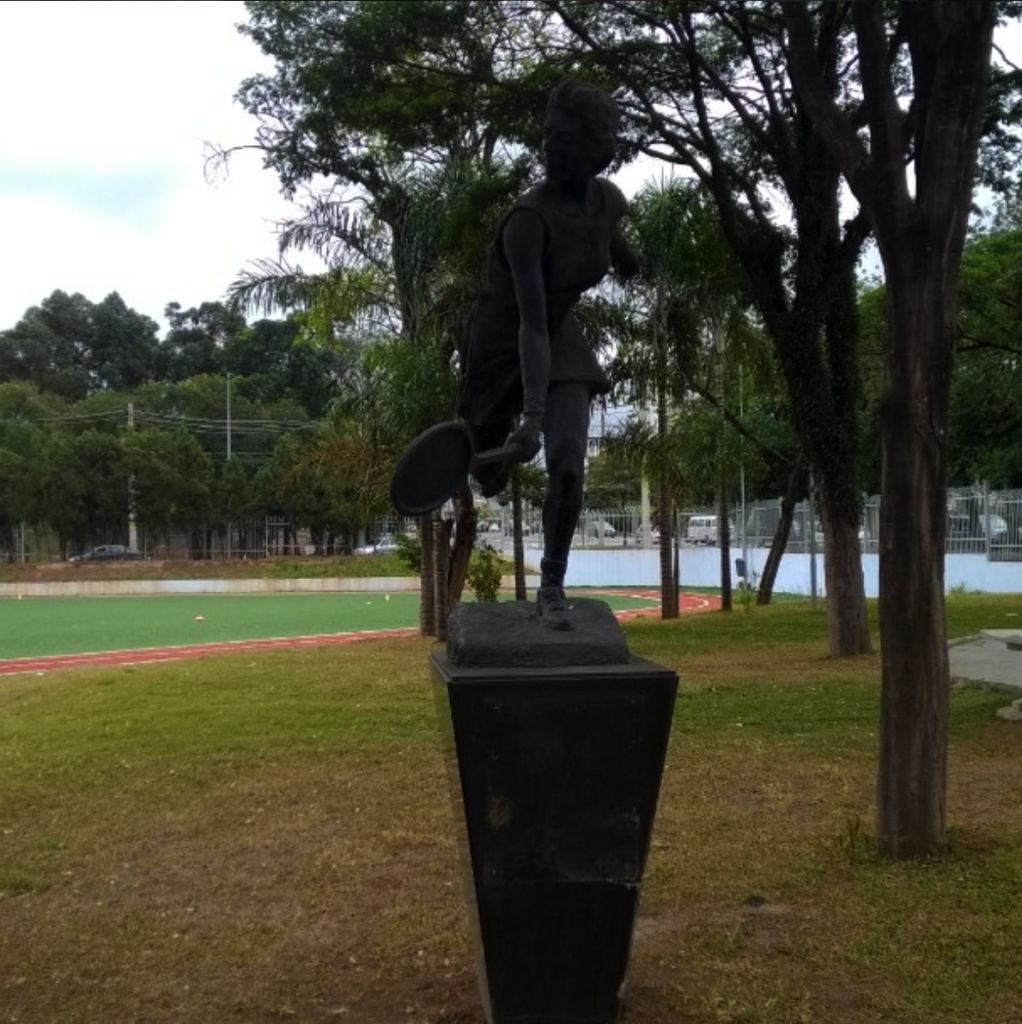
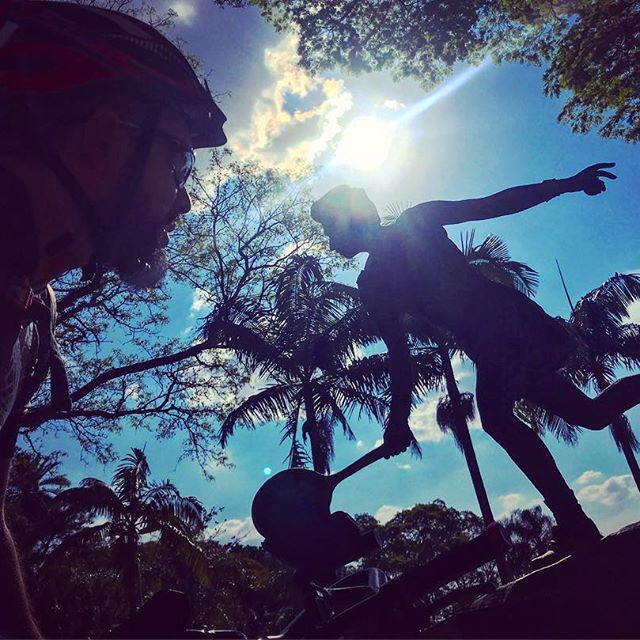

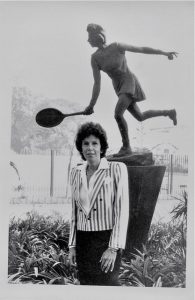
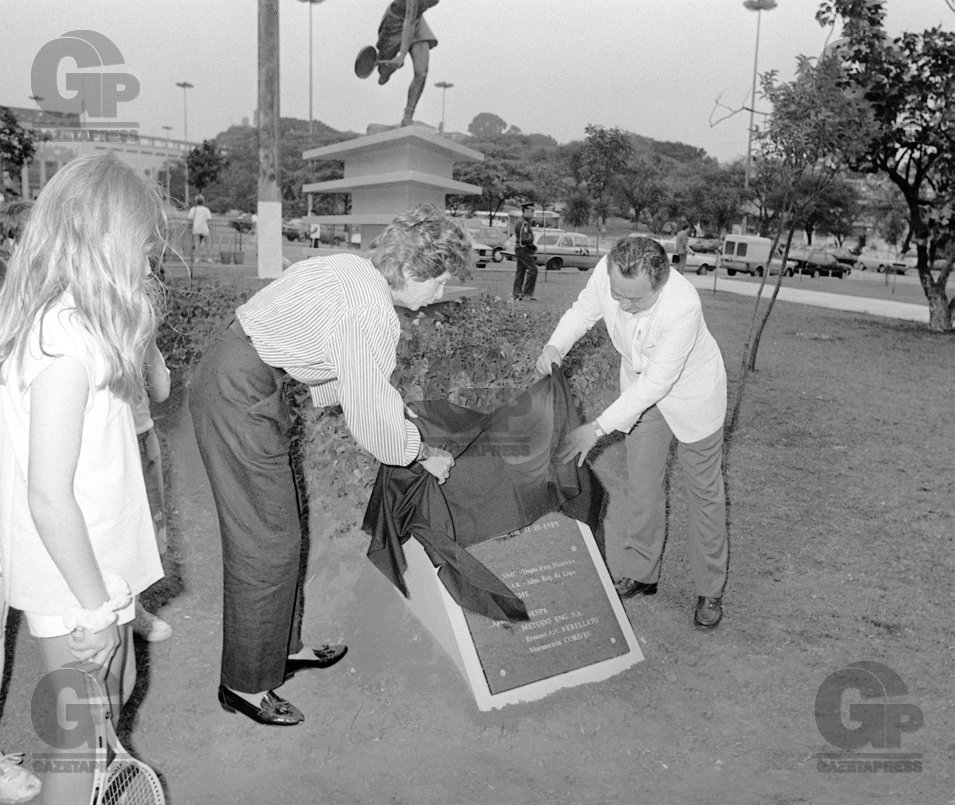
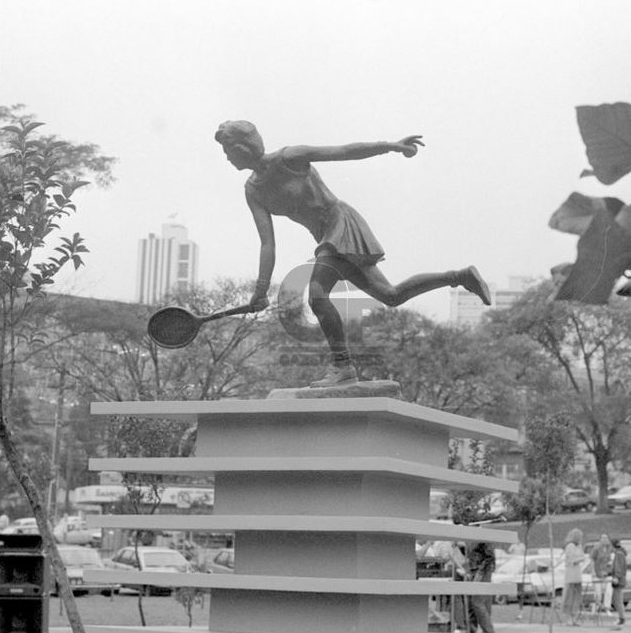
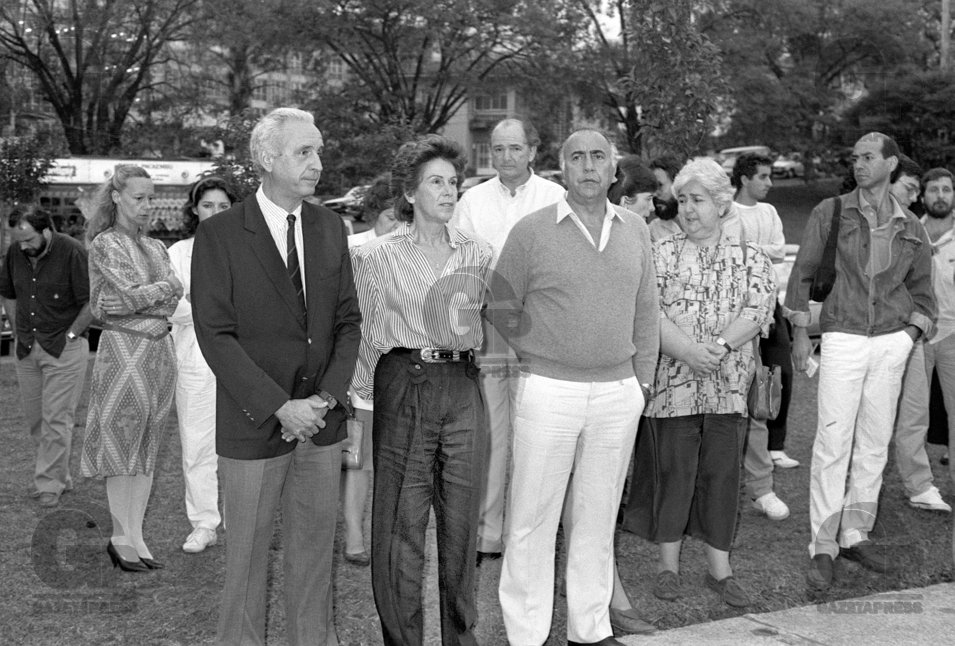
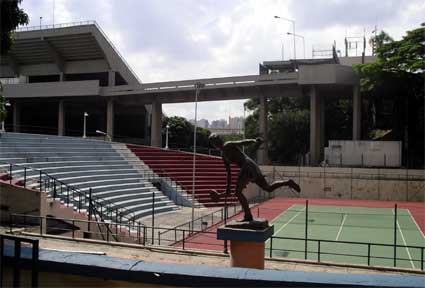
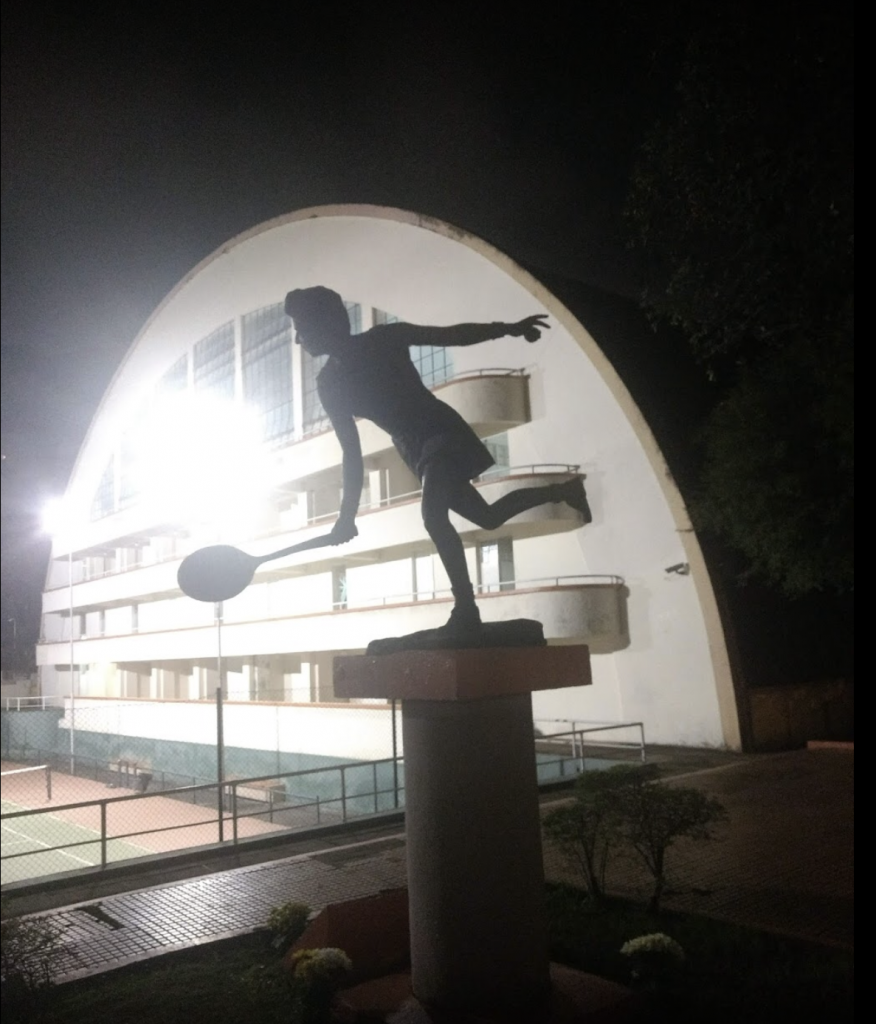
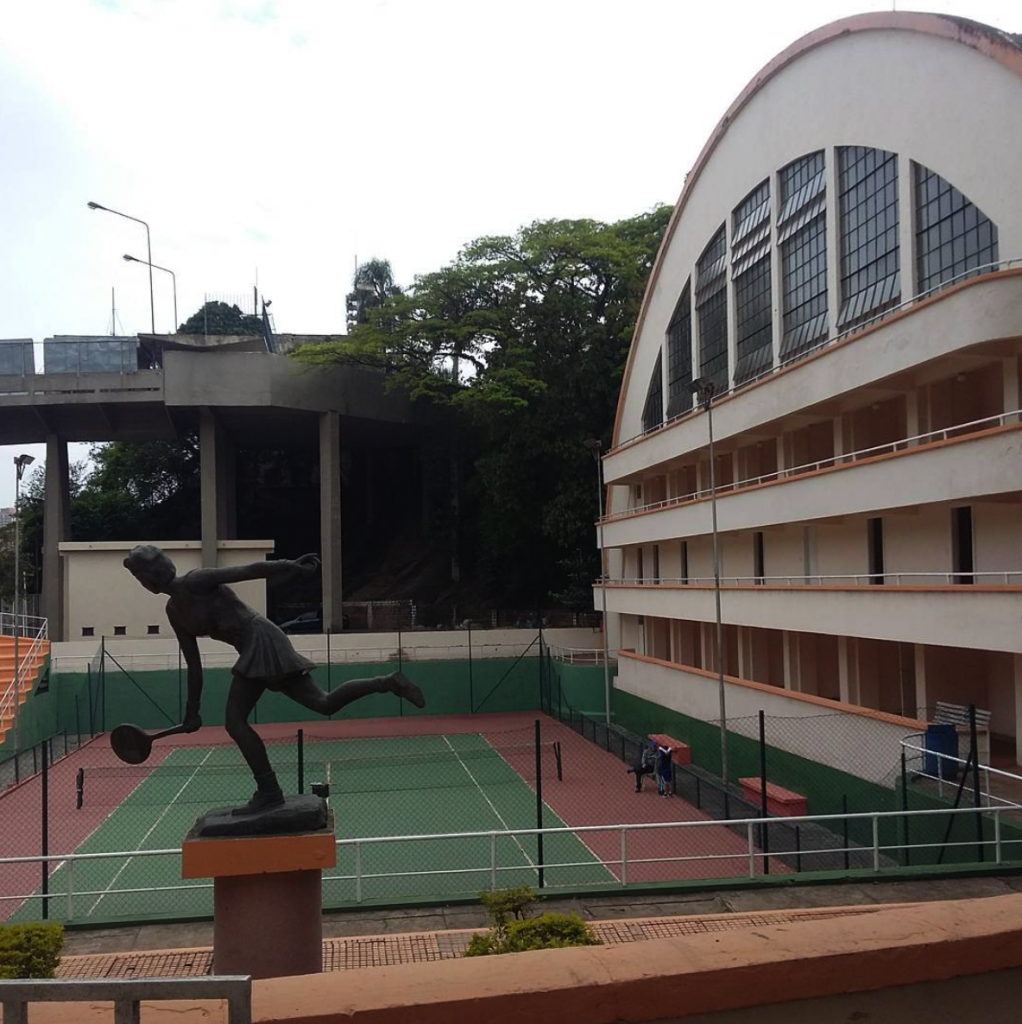
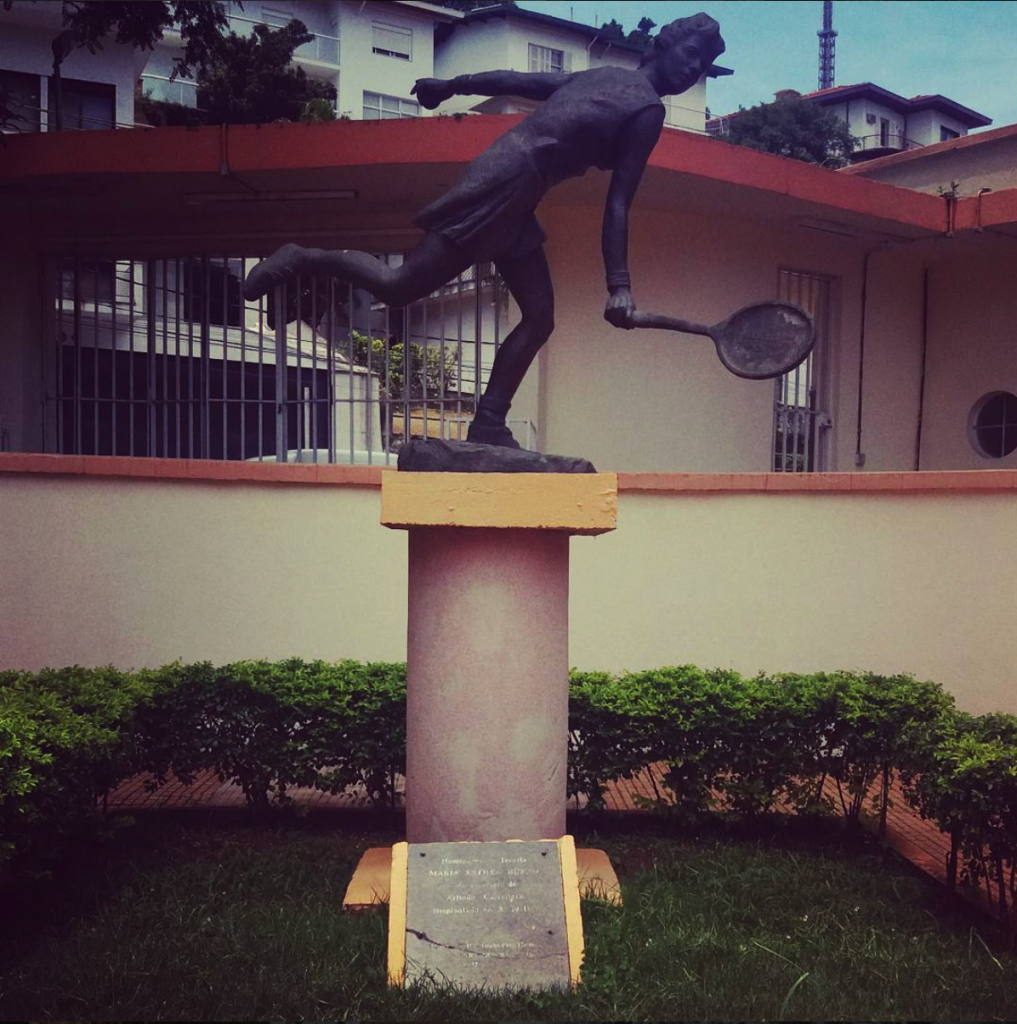
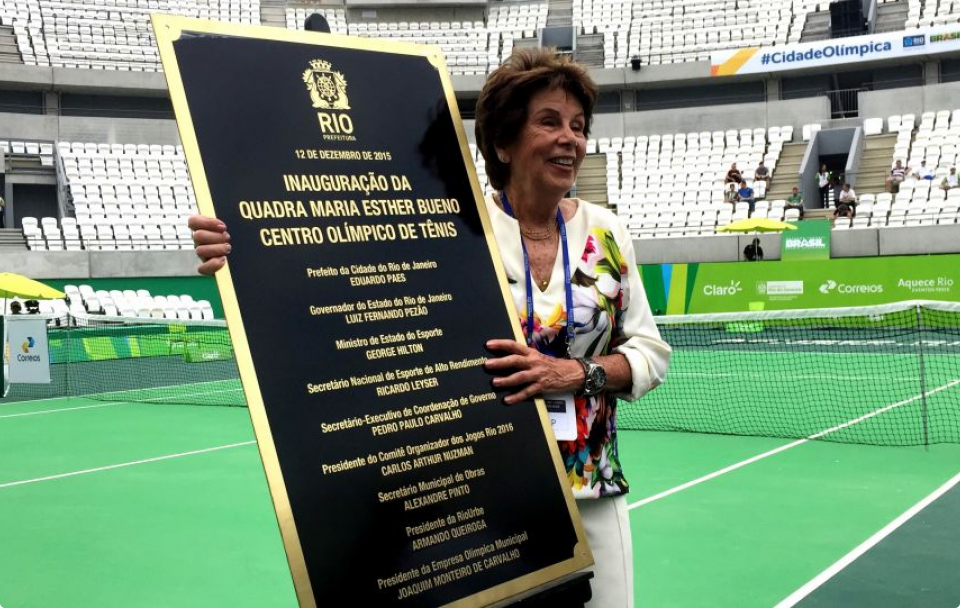
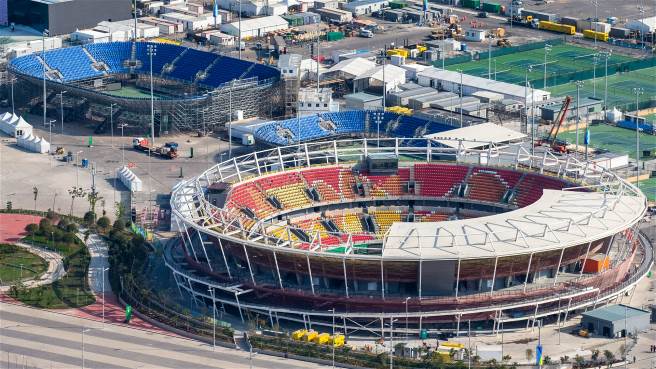

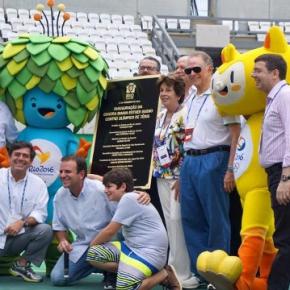
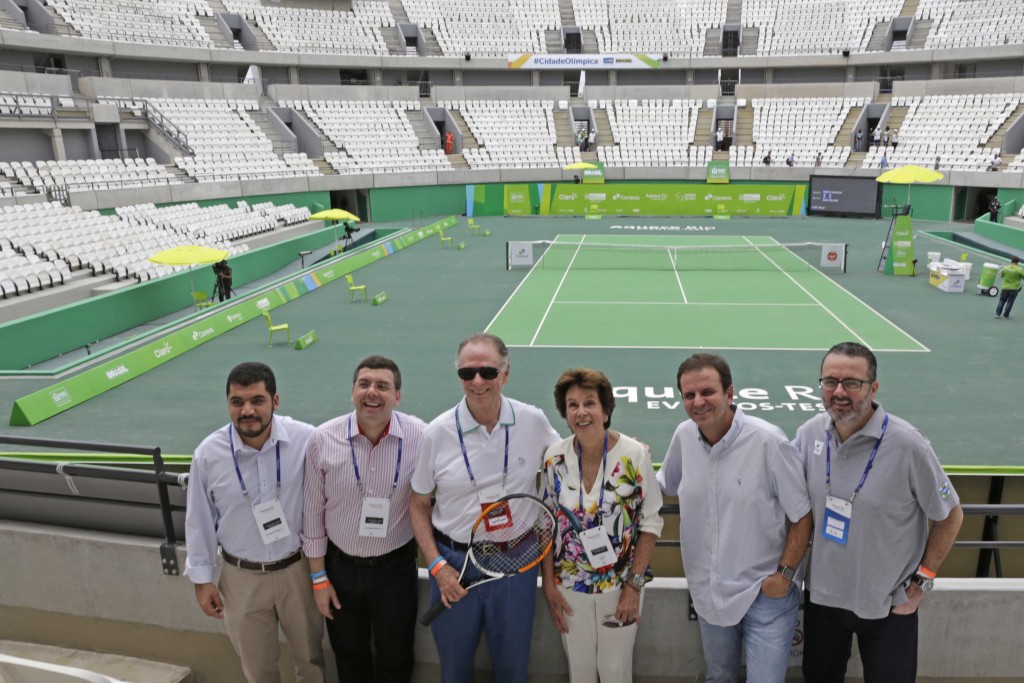
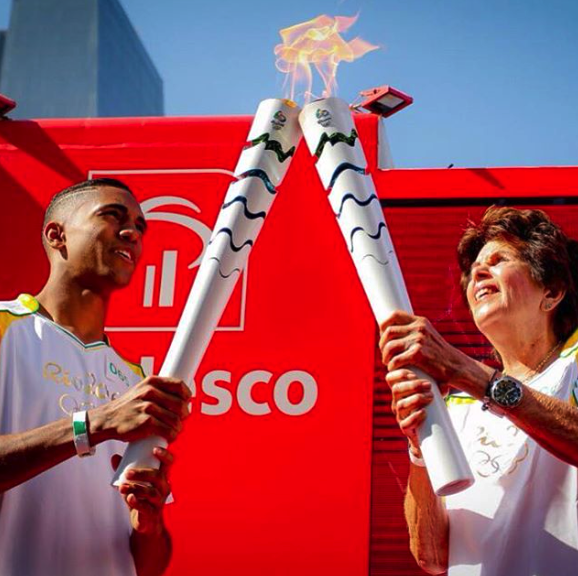
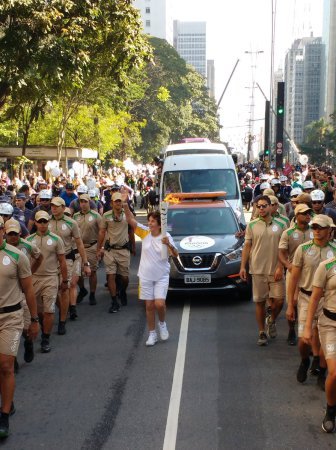
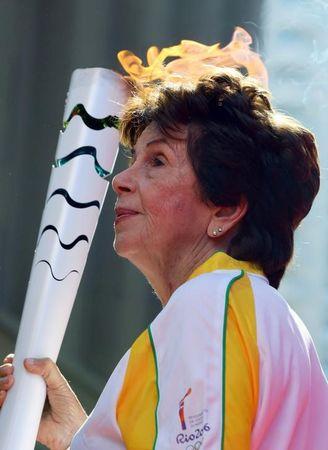
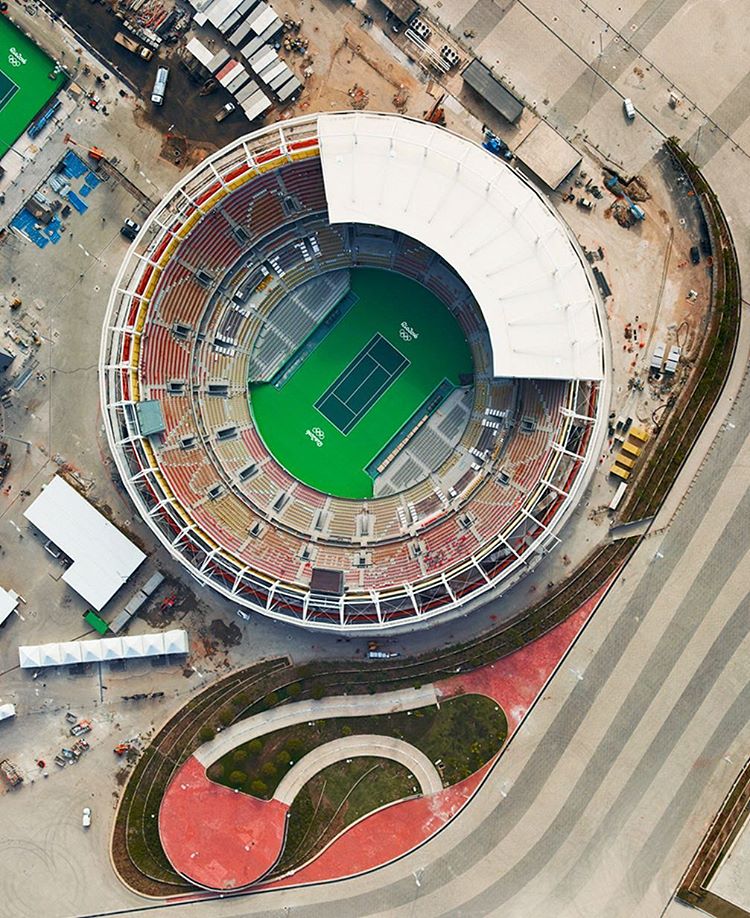
![The Brazilian flag is raised [AP Photo/Matt Dunham]](http://www.mariabueno.org/wp-content/uploads/2016/08/IMG_4969.jpg)
